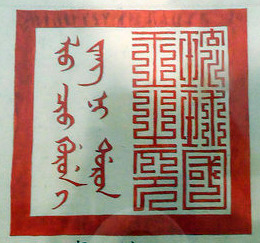Manchus

- Japanese: 満州民族 (manshuu minzoku)
- Chinese: 滿族 (Mǎnzú)
The Manchus are a nomadic steppe people from what is today northern China, or Manchuria. Manchus ruled China under the Qing Dynasty after seizing control from the Han Chinese Ming Dynasty in 1644.
In a classic example of how ethnic identity can change over time, and even be invented, the word Manchu only dates back to around 1636. Culturally if not ethnically related to the Mongols and claiming descent from the Jurchens, the Manchus first coalesced into a unified "Manchu" identity around that time, less than ten years, in fact, before taking over China.
Though a separate ethnic group from the Han Chinese, who introduced numerous significant cultural changes to China, their dynasty was so long-lasting, and the cultural changes so deeply ingrained into Chinese life by the 19th century, that much of what is seen or "known" in the West as stereotypically Chinese in fact derives from Manchu culture, imposed upon the Chinese in the mid-to-late 17th century, and part of Chinese "tradition" no earlier than that. Some examples of this include wearing one's hair long and braided in a queue, the particular type of round hat typically associated with the queue, and the cheongsam or qipao, the stereotypical slim Chinese dress with off-center buttons.
Origins
The Manchus as a group emerged in the early 17th century, out of a society of Jurchen, Mongol, Korean, and Han Chinese people brought together by the Jurchen leader Nurhachi in the 1610s-1620s, and named "Manchu" by Nurhachi's son and successor Hong Taiji, around 1636. By 1644, there were roughly one million people claiming Manchu identity.
The Manchu homeland came to be known as "Manchuria" (C: Mǎnzhōu, J: Manshû) around that time, and can be widely seen to possess that name in English-language publications, maps, and globes, from the early 18th century onwards. Yet, whether in response to the puppet state of Manchukuo (C: Mǎnzhōuguó, J: Manshûkoku) controlled by the Japanese from 1932-1945, or whether out of nationalistic desire to claim the region as an integral part of China (even though it wasn't prior to the Qing), Chinese today often insist on calling the region "Northeast China" (C: Zhōngguó Dōngběi) or "The Three Northeast Provinces" (Dōngběi sānshěng).
Qing Dynasty
During the Qing Dynasty, the Manchus were the elite ruling class. Many enjoyed a sort of dual life, maintaining various Manchu customs and practices, as well as Chinese ones. Many Manchu practiced horseback riding, archery, hunting, and other "traditional" steppe nomad practices, as well as Chinese practices such as calligraphy, poetry, music, and tea drinking. They communicated in both Chinese and Manchu spoken and written languages, and observed a combination of Tibetan Buddhist (Lamaist) and native steppe nomad shamanistic religious practices.
References
- Robert Tignor, Benjamin Elman, et al, Worlds Together, Worlds Apart, vol B, Fourth Edition, W.W. Norton & Co (2014), 502.
- Jonathan Spence, The Search for Modern China, Second Edition, W.W. Norton & Co. (1999), 41.